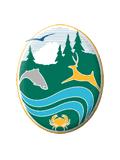 © Pete Saloutos/Panoramic Images (Washington Title Image Large)
© Pete Saloutos/Panoramic Images (Washington Title Image Large)

Washington Department of Fish and Wildlife
Our Mission
Sound Stewardship of Fish and Wildlife
http://wdfw.wa.gov/mission.htm
Our Focus
The Washington Department of Fish and Wildlife (WDFW) consists of three major resource sections: Fish Program, Habitat Program, and Wildlife Program. Visit our website at http://wdfw.wa.gov
Areas of Our Programs’ Focus
Salmon Recovery – WDFW is a national leader in providing the science that will make wild salmon recovery a reality. The many facets of WDFW’s salmon recovery effort provide natural resource managers, local governments, volunteers, educators and other citizens with the information and resources they need to become effective participants in salmon recovery. Visit us at http://wdfw.wa.gov/recovery.htm
Comprehensive Wildlife Conservation Strategy – In 2005, Washington, along with forty-nine states and six territories, completed a Comprehensive Wildlife Conservation Strategy to fulfill a federal requirement to obtain funding from the State Wildlife Grants (SWG) program. It was one of the farthest-reaching national conservation efforts in nearly 30 years. Visit us at http://wdfw.wa.gov/wlm/cwcs/
Threatened and Endangered Species Recovery – In 1978, a Nongame Program was established at the then Washington Department of Game. Biologists in the program reviewed literature and interviewed other wildlife resource professionals to create a list of species of concern. Their intent was to identify species characterized as rare, sensitive, uncommon, peripheral, or deserving special management. We are now the Wildlife Diversity Division, and our latest success story is the hatching, rearing and release of 500 Oregon Spotted Froglets into an unspoiled wetland in the South Puget Sound area. http:/wdfw.wa.gov/wildlife/management/endangered.html
Watchable Wildlife – Watchable wildlife includes a wide array of state animals, some as common as a familiar bird at a backyard feeder, some briefly passing through on seasonal migrations, some rarely-seen species that provide the dedicated viewer with a reward for hours of patient waiting. Besides the animals themselves, watchable wildlife describes an increasingly popular pursuit for many residents. Visit us at http://wdfw.wa.gov/viewing/wildview.htm
WDFW Education – Education is a term that represents different things to many people, each with his or her own personal definition of what it means. For some, education is a brochure, for others it is a videotape and for some it is a formal classroom presentation. To others, education is seen as more of a process than a product; a process that includes a variety of products in a variety of settings. See what WDFW is doing at http://wdfw.wa.gov/resfored.htm
Environmental Review and Planning Assistance – WDFW’s Habitat Program conducts many diverse programs to provide project review and technical guidance assistance to city and county planners, as well as public and private landowners. Visit us at http://wdfw.wa.gov/habitat/project_planning.html





